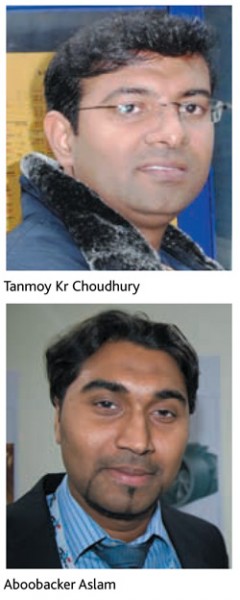With more stringent sustainability requirements and new market demands, air-moving equipment manufacturers are placing more energy-efficient and higher quality systems on offer. The challenge, however, is to move the products through a market that is observed to be still largely governed by price. Jerome Sanchez has the report.
With more stringent sustainability requirements and new market demands, air-moving equipment manufacturers are placing more energy-efficient and higher quality systems on offer. The challenge, however, is to move the products through a market that is observed to be still largely governed by price. Jerome Sanchez has the report.
 With the observed gradual recovery and stabilisation of the GCC markets has come the steady increase in regional construction activities, which in turn, is seen to boost the demand for HVAC equipment and its allied products. New market demands and more stringent sustainability regulations have prompted air-moving equipment manufacturers to ramp up their R&D in the interest of manufacturing, and offer more energy-efficient equipment. However, while many aspects of the industry and of product development have evolved, industry players agree that there seems to be one reality that has remained unchanged: Price still predominantly governs the market.
With the observed gradual recovery and stabilisation of the GCC markets has come the steady increase in regional construction activities, which in turn, is seen to boost the demand for HVAC equipment and its allied products. New market demands and more stringent sustainability regulations have prompted air-moving equipment manufacturers to ramp up their R&D in the interest of manufacturing, and offer more energy-efficient equipment. However, while many aspects of the industry and of product development have evolved, industry players agree that there seems to be one reality that has remained unchanged: Price still predominantly governs the market.
In the face of this market tendency, the challenge for air-moving equipment manufacturers is to strike a balance between minimising the total acquisition cost of the equipment and offering sustainable products that consistently evolve and comply with the requirements set by the market and regulatory authorities.
‘Construction is moving at a greater pace’
The air-moving equipment sector in the GCC is said to be progressing at a stable and even pace. After the recent economic downturn that considerably affected global markets, the sector appears to have steadied itself, largely owing to the gradual stabilisation of the regional construction market.
Tanmoy Kr Choudhury, R&D and Technical Manager at Maico Gulf, shares the view that the UAE, Qatar and Saudi Arabia are the main growth areas for the HVAC industry in the GCC. “A clear regulatory environment and the governing of private investments in infrastructure create a favourable investment climate in the UAE,” says Choudhury, and adds that in Saudi Arabia, the number of ongoing mega projects bode well for the entry of international firms. In his opinion, the growing private investment would provide greater opportunities for large foreign contractors to increase their involvement in construction projects in the country. “As construction industries in [other] Gulf countries stagnate, construction companies look to Saudi Arabia for opportunities,” he observes. Aboobacker Aslam, Sales and Marketing Manager, Systemair, makes a stronger assertion, saying that Saudi Arabia is the predominant mover in the GCC, and that the UAE is gradually moving out of a static period, as the country is looking forward to positive construction activities in the medium- and long-term.
 Speaking against the backdrop of Qatar’s continuing endeavour to develop its non-oil sectors, Choudhury says the shift in the country’s economic priority provides crucial support to its infrastructure development. “Hosting the 2022 FIFA World Cup,” he adds, “should [also] yield considerable contracts across the construction and infrastructure sectors.”
Speaking against the backdrop of Qatar’s continuing endeavour to develop its non-oil sectors, Choudhury says the shift in the country’s economic priority provides crucial support to its infrastructure development. “Hosting the 2022 FIFA World Cup,” he adds, “should [also] yield considerable contracts across the construction and infrastructure sectors.”
While the UAE, Qatar and Saudi Arabia are identified as major growth areas for the industry, Choudhury says that Oman and Kuwait are other emerging markets for HVAC equipment. Commenting on Oman’s potential, he says: “Growing tourism and transport infrastructure offer opportunities for developers and business in the country.” In addition, he says that the diversification of Oman’s economy will lead to a number of construction contracts and investment into accompanying infrastructure.
Speaking about Kuwait, Choudhury shares his opinion that the tight integration of infrastructure development among Gulf States will provide opportunities for Kuwaiti firms to win contracts in the region.
Some industry challenges
Finding the sweet spot:
In the interest of capitalising on the industry’s new-found stability and in order to meet the market’s new demands, air-moving equipment manufacturers have stepped up their product development and boosted their existing product line.
One challenge for industry players, however, is how to keep prices competitive and offer high quality products at the same time, as there exists a general notion that price is still king when it comes to HVAC product selection. Moreover, it has been widely observed that product efficiency and reliability are only considered for select quality projects.
Choudhury agrees to this view when he says, “A recent interest in green HVACR systems has focused [market] attention on a number of HVACR system strategies that are seen to support the intents and expectations of green design, though very less attention [has been given] on equipment selection and product efficiency.” He sounds a warning that in such a high supply-demand market, project specification should not be compromised with an alternative specification.
Industry experts concur with Choudhury, as they observe that cutting corners in a project can have a huge impact on the total energy usage in buildings. In addition, undercutting can potentially lead to an unhealthy market competition and to the proliferation of substandard products, believe industry players. With very little price headroom, they find it challenging to develop and innovate their air-moving equipment.
Limited knowledge and awareness:
Despite the fact that the concept of sustainability has moved into the collective psyche of the HVAC industry, there is still a pressing need to create awareness and educate stakeholders regarding sustainable products and practices, say industry players. Choudhury seconds this while speaking in the context of Indoor Air Quality: “There is a need to increase understanding [of the market] about the methods of controlling indoor air contaminants. The MEP consultants, in particular, should incorporate these specifications into their designs.” Aslam supports this view, and says that the lack of knowledge and understanding in the market regarding the relationship between cost and return, for instance with respect to the improvement of IEQ, is a key concern in the air-moving equipment sector.
Industry players point out that basic norms are disregarded, product manuals are not studied and compromises are made in the installation process. For instance, improper fan selection, which not only leads to an overuse of energy but could also cause severe damage to the ductwork, could, in the long run, be attributed to the observed deficiency in good and recommended installation practices. Industry players, therefore, warn that designs that have a negative effect on energy usage due to unnecessarily high static pressure requirements, and lack of timely maintenance could have an adverse effect on both energy cost and the environment.
The value of maintenance
In order to ensure that air-moving equipment contributes to occupant comfort and maintains its energy performance, Choudhury advices advocating regular maintenance practices and continuous commissioning. “Performance measurements should be done monthly or at least quarterly to provide operators with enough data to tell when systems are beginning to perform poorly,” he says, and adds that many building automation systems are already capable of providing hourly data on temperature humidity and energy use through BMS or local control systems.
“Maintenance is an absolute necessity and is inevitable for any HVAC product to ensure good IEQ,” says Aslam, but he sounds a warning that maintenance is too often neglected. “This leads to consequent issues, like leakage and pressure build-ups through dirty filters, among others, which may result in poor IEQ.”
Conclusion
Though the regional HVAC market has shown some signs of maturity in recent years, industry players acknowledge the fact that the market has yet to fully shift its priority from acquisition cost to equipment efficiency and quality. The challenge, say the players, is not only limited to educating the end-users on the benefits of high quality products, but some contractors and designers should also be oriented on installation and maintenance of best practices, and on the adverse effects of erroneous product specification and selection. In the interest of introducing sustainable systems and practices to the market, air-moving equipment manufacturers aim to strike a balance between offering an innovative product and encouraging the market to look beyond the price tag.
Copyright © 2006-2025 - CPI Industry. All rights reserved.